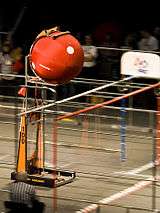No Limits (FIRST)
No Limits is the 2004-05 FIRST Lego League challenge theme. It focused on solutions for aiding people with physical disabilities.[3] The year's theme was introduced by the story Late for Lunch by James Patrick Kelly,[4] which the described the life of a disabled child.
| No Limits | |
|---|---|
 | |
| Challenge Number | 7 |
| Released In | 2004 |
| Kids | 50000 |
| Teams | 5859[1] |
| Tournaments | 210[2] |
Project
Teams were tasked with selecting a public facility and determining how accessible it is.[4] From this, they would create an innovative solution to improve its accessibility. At competition, teams presented their research and solution to judges.[3]
Gameplay
The table performance portion of No Limits is played on a 4 ft by 8 ft field rimmed by wood boards. At competition, two of these fields are placed together to form an 8 ft square. In each 2 1/2 minute match, a team competes on each field with their robot to earn points manipulating the mission models.
One of the mission models, Play ball, straddles both fields in the center. 50 points are earned by the team whose color of ball is the center goal.[5] The touch penalty objects are balls colored red and blue; 8 exist of each color.[6] They are worth 5 points each (regardless of color) if they are on your side of the Play Ball basket, and worth 2 points if they are on your playing field.[5] Balls that are not in the basket are subject to the touch penalty and one is removed from your field each time the robot is touched outside of base.
Missions
All the missions of No Limits focus on aiding the disabled:[5][7]
- Put the CD away - up to 40 points
- Play ball (center goal) - 50 points
- Play ball (basket) - up to 80 points[note 1]
- Climb the stairs - up to 45 points
- Feed the pets - up to 45 points
- Open the gate - up to 35 points
- Read the bus route signs - 35 points
- Push in the chairs - up to 30 points
- Serve dinner - up to 45 points
- Remove the glasses - 40 points
Notes
- Each ball is worth 5 points, and each team has 16 balls for a possible maximum of 80.
References
- "The Challenge". FIRST. Retrieved 8 August 2011.
- "Past FLL Challenges". FIRST. Archived from the original on 22 March 2009. Retrieved 6 August 2011.
- "LEGO League tournament features "No Limits" at TTU this Saturday". Tennessee Technological University. Archived from the original on 27 September 2011. Retrieved 8 August 2011.
- "2004 Project" (PDF). Munster Robotics. Archived from the original (PDF) on 28 March 2012. Retrieved 8 August 2011.
- "2004 Missions" (PDF). Munster Robotics. Archived from the original (PDF) on 28 March 2012. Retrieved 8 August 2011.
- "2004 Q&A" (PDF). Munster Robotics. Archived from the original (PDF) on 28 March 2012. Retrieved 8 August 2011.
- "Worcester Polytechnic Institute Hosts No Limits Challenge, FIRST LEGO League (FLL) Tournament". Worcester Polytechnic Institute. Retrieved 8 August 2011.
